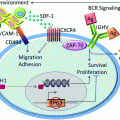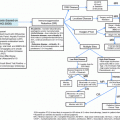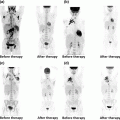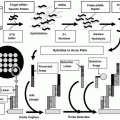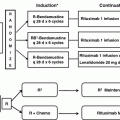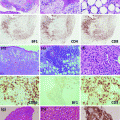© Springer International Publishing Switzerland 2015
Andrew M. Evens and Kristie A. Blum (eds.)Non-Hodgkin LymphomaCancer Treatment and Research16510.1007/978-3-319-13150-4_14Allogeneic Hematopoietic Cell Transplantation in Non-Hodgkin’s Lymphomas
(1)
City of Hope National Medical Center, Hematology and Hematopoietic Cell Transplantation, 1500 East Duarte Road, Duarte, CA 91010, USA
Abstract
Allogeneic hematopoietic cell transplant (alloHCT) has emerged as a potential curative treatment for advanced non-Hodgkin’s lymphoma (NHL), especially for patients with chemorefractory disease, relapsed after prior autologous HCT and those with relapsed lymphoma who failed to collect adequate stem cells for autologous HCT. There are several phase II studies supported the role of alloHCT in low-grade lymphomas, but the data is scarce on the other subtypes of lymphomas. However, retrospective registries studies highlighted the inferior outcomes of alloHCT in aggressive lymphomas, with unacceptable higher relapse rate and non-relapse mortality when compared to low-grade lymphomas. Patients with chemorefractory disease and those with active disease at alloHCT had poor outcome. Therefore, incorporation of new target therapies to induce remission prior to transplant or as a bridge to alloHCT may lead to better outcome of alloHCT in NHL. Furthermore, well design prospective studies of alloHCT in NHL and employment of novel transplant approaches tailored toward specific histological subtype are urgently needed.
Keywords
Allogeneic HCT for lymphomaTransplantation for NHLReduced-intensity allo-HCT for NHL1 Introduction
Non-Hodgkin’s lymphoma (NHL) includes heterogeneous entities of mature lymphoid malignancies that vary in biology, clinical behavior, and treatment. Chemotherapy alone remains the most utilized upfront therapy for the majority of NHL cases. Chemotherapy alone is capable of curing roughly half of aggressive NHL cases and attaining long-term control in the majority of indolent subtypes. Nevertheless, there is a well-established role for autologous (auto) hematopoietic cell transplant (HCT) in relapsed chemosensitive aggressive NHL, and occasionally, it has a role in the upfront setting such as consolidation modality for mantle cell lymphoma (MCL). Although auto-HCT is a safe procedure, and it is associated with low morbidity and mortality, it has a limited role in heavily pretreated or relapsed patients that had failed to mobilize adequate stem cells, chemorefractory relapsed lymphomas, and those who relapsed/progressed after prior auto-HCT. In those situations, allogeneic HCT (allo-HCT) may be the only curative option, and it has been shown to be effective but is also associated with high transplant-related morbidity and mortality (TRM). In this review, we will discuss the current available evidence for the role of allo-HCT in the different subtypes of NHL.
2 Allogeneic HCT in Indolent B-Cell NHL
Follicular lymphoma (FL) is the prototype of low-grade lymphoma. It is characterized by indolent clinical behavior and sensitivity to chemotherapy. However, the natural history of FL involves frequent disease recurrences and shorter response durations with each relapse. Eventually, FL progresses to become chemoresistant, and portion of cases transforms to more aggressive lymphoma subtypes. Despite long survival that exceeds a decade in more recent studies, FL is considered an incurable disease with conventional chemotherapy, and there is an increasing interest in using allo-HCT as a curative modality in advanced disease and younger patients.
In relapsed/refractory (R/R) FL, phase II prospective studies from the MD Anderson Cancer Center (MDACC), the Cancer and Leukemia Group B (CALGB 10901), the Spanish group (GELTAMO), and the Canadian transplant group have established the feasibility of reduced-intensity conditioning (RIC)/non-myeloablative conditioning (NMA) allo-HCT and have documented low relapsed/progression risk (RR) as well as low non-relapse mortality (NRM) [1–4]. Investigators from MDACC prospectively treated 47 chemosensitive relapsed FL with allo-HCT following NMA conditioning with FCR (fludarabine, cyclophosphamide, and rituximab). The majority of patients transplanted from matched–related donors (MRD), and 19 % had already failed prior autograft. Long-term follow-up demonstrated low RR and NRM of 6 and 13 %, respectively, in addition to high 11-year progression-free survival (PFS) and overall survival (OS) of 72 and 78 %, respectively. Subsequently, rituximab was replaced with 90Y-ibritumomab (YFC), and another 26 relapsed FL patients were treated prospectively. Among the YFC cohort, more patients were chemorefractory compared to the FCR cohort (38 vs. 0 %) and have undergone transplant from matched unrelated donor (MUD) (42 vs. 4 %). Relapse risk and NRM were low, and both were 8 %. Three-year PFS and OS were 85 and 88 %, respectively. Although pretransplant PET activity did not predict outcomes in either cohort, there was a trend toward decreased 3-year OS in the FCR cohort for patients with positive PET activity (57 % vs. 90 %. P = 0.06). Complete remission (CR) was achieved in the majority of patients after transplant, including 9 of 10 chemorefractory patients, and there was no significant difference in PFS or OS based on chemosensitivity. The 6-year OS for chemorefractory disease was 80 %, which is very promising in this high-risk cohort [1].
The CALGB 109901 is a prospective phase II study that enrolled 44 patients with relapsed chemosensitive indolent NHL and chronic lymphocytic leukemia (CLL), including 16 patients with FL. All patients underwent allo-HCT from MRD using RIC with FC. The RR and NRM rates were 19 and 9 %, respectively. The 3-year event-free survival (EFS) and OS rates for the FL cohort were 75 and 81 %, respectively, which were higher than their counterpart patients with CLL and other indolent lymphomas in the study [2].
The Spanish group (GELTAMO) analyzed the outcomes of 2 prospective protocols including 37 patients with FL who had undergone allo-HCT from MRD using RIC with fludarabine and melphalan (Flu/Mel). Among enrolled patients, 18 % were chemorefractory and 46 % had already failed prior autograft. The 4-year RR and NRM rates were 8 and 37 %, respectively. Chemorefractory lymphoma prior to transplant was a risk factor for increasing NRM (P = 0.04). The 4-year PFS and OS rates for the whole group were 55 and 57 %, respectively. Disease status prior to transplant was associated with a trend toward improved PFS and OS after transplant, but it did not reach statistical significance. The 4-year OS in patients with CR, PR, and refractory disease were 71, 48, and 29 %, respectively (p = 0.09) [3].
The Canadian study used a different approach to treat R/R FL by applying tandem auto-HCT followed by NMA allo-HCT from MRD. Among 27 enrolled patients, 19 % were considered chemorefractory at the time of auto-HCT and 19 % had transformed histology. The conditioning regimen was BEAM (carmustine, etoposide, cytarabine, melphalan) or BEAC (carmustine, etoposide, cytarabine, cyclophosphamide) for auto-HCT and Flu/Cy (Fludarabine, cyclophosphamide) for allo-HCT, and the median time between the 2 transplants was 133 days. The Canadian approach was proven to be active and safe. There was no reported relapse during the follow-up period, and the NRM was as low as 4 %. The 3-year PFS and OS rates were 96 % for both. No cases of therapy-related MDS/AML was observed during follow-up [4].
However, retrospective analysis of transplant registries reported the outcome of allo-HCT in R/R FL were inferior to single center experiences, but these results provide more insights regarding the role of allo-HCT in FL. The largest analysis was reported by the Center for International Blood and Marrow Transplant Research (CIBMTR), in which myeloablative (MAC) (n = 120) was compared to RIC (n = 88) in patients who had undergone allo-HCT from MRD for R/R FL. Although 3-year OS (62 % vs. 71 %, p = 0.15) and PFS (55 % vs. 67 %, p = 0.07) were not different between RIC and MAC, respectively, there was an increased risk for lymphoma relapse after RIC in multivariate analysis (Relative risk = 2.97, p = 0.04). The 3-year probability for lymphoma progression was 8 % after MAC and 17 % after RIC in univariate analysis. Poor performance status (PS) and chemorefractory disease were associated with lower PFS and OS, and higher TRM [5].
In contrast to the CIBMTR analysis, the European Group for Blood and Marrow transplantation (EBMT) analysis compared the outcome of allo-HCT in 131 patients who had undergone allo-HCT MUD for R/R FL (RIC = 87, MAC = 44). The RIC cohort was older, more frequently had undergone prior autograft, and less frequently used ATG as part of conditioning compared to the MAC cohort. The 3-year NRM, RR, PFS, and OS rates were 33, 30, 47, and 51 %, respectively, for the whole cohort. No significant difference was noticed between RIC and MAC in the risk of acute or chronic graft versus host disease (GVHD); however, the occurrence of acute GVHD (aGVHD) was associated with higher risk of NRM, and shorter PFS and OS. In multivariate analysis, lower NRM and higher PFS and OS were seen for patients who had undergone RIC, and lower PFS and OS for patients who had prior autograft. Of 61 patients with prior autograft, 3-year NRM, RR, PFS, and OS rates were 42, 19, 39, and 42 %, respectively [6].
The role of T cell-depleted RIC allo-HCT in FL was the focus of the United Kingdom (UK) analysis. Among 82 patients who were conditioned with Flu/Mel/Alemtuzumab, 9 % had chemorefractory disease, 26 % had failed prior autograft, and 54 % received transplant from MUD. The study reported low NRM (15 %), aGVHD (13 %), and chronic GVHD (cGVHD) (18 %). The 4-year PFS and OS rates were 76 % for the whole cohort. Post-transplant, 52 % of 64 evaluable patients with chimerism study had mixed chimerism (MC). Of 28 patients who received DLI for MC, 61 % achieved full chimerism (FC). The 4-year RR was higher for patients with persistent MC compared to FC cohort (36 % vs. 10 %; p = 0.03). There was a trend toward higher NRM in MUD recipients compared to MRD (22 % vs. 8 %, p = 0.08). The 4-year PFS was lower in MUD compared to MRD (64 % vs. 90 %; p = 0.012), and in patients who had prior autograft compared for those without (57 % vs. 83 %; p = 0.016), but there was no difference based on disease chemosensitivity at the time of transplant (p = 0.133). Nevertheless, in multivariate analysis, MRD was the only variable associated with improved PFS (p = 0.035) and OS (p = 0.037). Salvage DLI was effective for relapse after transplant as 10 of 13 patients (77 %) achieved CR, and this including 9 of whom had a durable response [7].
The Fukuoka BMT Group from Japan analyzed the outcome of 30 R/R FL who had undergone allo-HCT (MAC = 43 %, RIC = 57 %), including 50 % with chemorefractory disease and 7 % with prior autograft. There was no difference in outcomes between RIC and MAC. The 2-year RR, NRM, PFS, and OS rates were 20, 33, 47, and 47 %, respectively, for the whole cohort [8].
3 Allogeneic HCT in Aggressive B-Cell NHL
3.1 Diffuse Large B-Cell Lymphoma (DLBCL)
Combination chemotherapy/immunotherapy is a curative treatment in over half of newly diagnosed diffuse large B-cell lymphoma (DLBCL); however, some patients will be refractory to upfront chemotherapy and some will relapse after initial CR. Auto-HCT is considered the standard practice for relapsed chemosensitive DLBCL, with a 5-year EFS of 46 % reported in those transplanted in the pre-rituximab era [9]. Nowadays, rituximab is given routinely upfront and the outcome for those with relapsed DLBCL seems inferior. In the CAROL randomized study comparing salvage R-ICE versus R-DHAP in R/R DLBCL, and in which the treatment was followed by auto-HCT in responders, the 3-year EFS was only 20 % in those with prior rituximab exposure, high IPI score and/or short prior duration of remission (less than one year) [10].Therefore, auto-HCT is not justified in these cases, neither in those who relapsed/progressed after prior autograft, those with relapsed DLBCL who fail to collect enough cells to undergo auto-HCT, nor those who are chemorefractory to salvage therapy. Allogeneic HCT is considered a potential curative therapy in the formerly mentioned situations; however, the lack of prospective data precludes deriving a definitive role for the procedure. Furthermore, in contrast to FL, DLBCL seems to be associated with higher NRM and post-transplant RR, and therefore lower long-term outcomes.
Retrospective analysis from the CIBMTR included 396 patients who had undergone allo-HCT for R/R DLBCL [(MAC = 165 (42 %); RIC = 143 (36 %); NMA = 88(22 %)]. Recipients of MAC were younger, had more advanced stage and B-symptoms at diagnosis, had more chemorefractory disease at the time of transplant, and less frequently had undergone prior autograft compared to RIC/NMA. The 5-year NRM was higher in MAC recipients compared to RIC and NMA recipients (56 % vs. 47 % vs. 36 %, p = 0.007), while 5-year RR rate was lower in MAC compared to RIC/NMA (26 % vs. 38 % vs. 40 %, p = 0.031). There was no significant difference in 5-year PFS (15–25 %) and OS (18–26 %) according to conditioning regimen. Acute GVHD and chronic GVHD were similar among the different groups. In multivariate analysis, NRM was greater in patients with poor PS, MUD, and chemorefractory disease. Relapse rate was higher in patients with chemorefractory disease and those who had not undergone prior rituximab therapy. DLBCL progression/relapse was uncommon after 1 year post-transplant [11]. Another analysis from the CIBMTR database was restricted only on patients who had their first transplant for DLBCL, and compared the outcomes for auto-HCT (n = 837) vs. MAC allo-HCT from MRD (n = 79). Allo-HCT recipients had higher risk features, including more chemorefractory disease (42 % vs. 15 %, p = <0.001). Relapse/progression rate was similar in both cohorts. Compared to auto-HCT, allo-HCT was associated with higher TRM, lower PFS, and lower survival. The significant difference in TRM, PFS, and OS was only seen in the first year after transplant; however, no difference in outcome was observed in one-year survivors [12].
In contrast to the CIBMTR, the EBMT (n = 101) and the GITMO (n = 165) analyses focused on the significance of salvage allo-HCT for those who had prior autograft in R/R DLBCL. The EBMT analysis compared the outcome of MAC (n = 37) and RIC (n = 64). RIC recipients were significantly older and had longer interval from diagnosis to transplant as well as longer interval from autograft to allo-HCT. There was no significant difference in PFS and OS between RIC and MAC, but there was a trend toward a higher NRM and lower RR in the MAC recipients. The 3-year NRM, RR, PFS, and OS rates were 28, 30, 42, and 54 %, respectively, for the whole cohort. In multivariate analysis, NRM was higher in those older than 45, had early relapse after autograft, and recipients of marrow graft, while RR was higher in the chemorefractory cohort [13]. In contrast, the GITMO analysis (RIC = 116; MAC = 49) reported 5-year NRM, PFS, and OS rates of 28, 31, and 39 %, respectively. Despite more chemorefractory patients treated with MAC compared to RIC (49 % vs. 27 %, p = 0.003), there was no significant difference in PFS or OS. In multivariate analysis, disease status at the time of transplant influenced PFS and OS, and donor type influenced PFS only. Twenty-three percent of 26 relapsed patients responded to DLI, but data regarding additional treatment and the durability of responses were missing [14].
The Seattle group examined the role NMA allo-HCT in 31 patients with R/R DLBCL. Seventy-five percent of the cohort had failed prior autograft, and 28 % were considered chemorefractory. The 3-year NRM, RR, PFS, and OS rates were 25, 41, 35, and 45 %, respectively. In multivariate analysis, disease sensitivity was associated with improved survival (3-year OS rate of 56 %) [15]. On the other hand, John Hopkins group examined the role of T cell-depleted MRD allo-HCT with R/R DLBCL and compared it to their experience with autograft in the same setting (allo = 45; auto = 138). Although allo-HCT recipients were more chemorefractory and heavily pretreated, they were younger and had earlier disease compared to auto-HCT recipients. Allo-HCT was associated with higher TRM (51 % vs. 24 %, p < 0.001), but the 3-year OS was not significantly different between transplant cohorts (auto = 33 %, allo = 24 %, p = 0.7). There was no difference in OS between chemosensitive (allo = 52 %; auto = 46 %) and chemorefractory disease (allo = 12 %; auto = 19 %). Continuous lymphoma relapse was seen overtime in auto-recipients, even after 4 years from transplant, but no relapse was seen in allo-recipients beyond 13 months of transplant, suggesting the graft versus lymphoma effect in allo-HCT [16].
Other retrospective analysis from United Kingdom (n = 48, including 18 transformed follicular) and France (n = 68) examined the role of RIC allo-HCT in R/R DLBCL. The UK cohort received alemtuzumab as part of conditioning regimen. Among 12 patients who received DLI ± chemoimmunotherapy for relapsed disease after transplant, 42 % achieved durable remission. The 4-year NRM, RR, PFS, and OS rates were 32, 33, 48, and 47 %, respectively. Donor type, prior autograft, and de novo versus transformed disease did not affect PFS or OS. Chemorefractory recipients (n = 8) had a dismal outcome as half relapsed and half died prior to day 100 [17]. The French analysis reported 1-year NRM of 23 %, and 2-year RR, PFS, and OS rates of 44, 49, and 41 %, respectively. Multivariate analysis showed CR at the time of transplant was associated with longer PFS and lower RR. The median time for relapse/progression was 3 months from the time of transplant, and only 3 patients relapsed beyond 1 year [18].
3.2 Other Aggressive B-Cell NHL
Burkitt’s lymphoma (BL) is a very aggressive subtype of NHL, and R/R BL is associated with dismal outcomes. Nevertheless, the role of transplant is not well defined in BL. Analysis using the CIBMTR database that included 128 patients with BL who had undergone allo-HCT between 1985 and 2007 showed 5-year RR, PFS, and OS of 27, 50, and 53 % for those transplanted in CR1, and 51, 19, and 20 % for those transplanted in non-CR1, respectively. For those who were not in CR at the time of transplant, the 5-year RR, PFS, and OS rates were 54, 11, and 12 %, respectively [19].
Richter’s syndrome (RS) is defined as transformed CLL into aggressive NHL, most commonly DLBCL. RS is more aggressive than de novo DLBCL, and autograft is recommended in CR1 for eligible patients. Analysis from the EBMT database identified 25 patients with RS who had undergone allo-HCT (RIC = 18; MAC = 7). The cohort included 36 % who were considered chemorefractory and 16 % with prior failed autograft. The 3-year NRM, RR, RFS, and OS rates were 26, 47, 27, and 36 %, respectively. Chemosensitive disease and RIC were associated with better EFS. Outcomes were compared to patients with RS who had undergone autograft, in which the majority had chemosensitive disease. The 3-year NRM, RR, RFS, and OS rates for autograft recipients were 12, 43, 45, and 59 %, respectively [20].
Transformed lymphoma (TL) is another aggressive form of NHL that develops in about a third of FL cases. The Canadian Blood and Marrow Transplant Group reviewed retrospectively the outcome of 22 recipients of allo-HCT and compared to 97 of autograft recipients for TL, and 53 who had received rituximab-containing regimen without transplant. TRM was higher in allo-recipients compared to auto-recipients (23 % vs. 5 %). There was no difference in post-transplant survival between allo-HCT and auto-HCT (45 % vs. 57 %, p = 0.12). Auto- but not allo-HCT was associated with superior survival in multivariate analysis when compared to rituximab-containing regimen. The 5-year PFS and OS rates from the time of transformation were 46 and 46 % for allo-recipients, 55 and 65 % for auto-recipients, and 40 and 61 % for non-transplant cohort [21]. Analysis from United Kingdom showed no difference in outcomes between de novo and transformed lymphoma for patients who had undergone allo-HCT [17].
4 Allogeneic HCT in Mantle Cell Lymphoma
Mantle cell lymphoma (MCL) is a unique form of NHL that shares the incurability feature of low-grade lymphoma and the clinical behavior of aggressive subtypes. Auto-HCT is part of MCL treatment in the upfront and the relapsed setting. Although allo-HCT was used in those with chemorefractory disease and those relapsed after prior autograft, there are no prospective studies that define the exact role.
Data from the CIBMTR compared the outcomes of auto (n = 381)- versus RIC allo-HCT (n = 138) in chemosensitive MCL and analyzed outcomes based on the timing of transplantation (early = 299, late 220). Early transplantation was defined as those who received transplant in PR1/CR1 with no more than two lines of prior chemotherapy. Allo-HCT was associated with higher NRM but lower RR in both early and late cohorts. There was no significant difference in 5-year OS for early (61 % vs. 62 %, p = 0.95) and late (44 % vs. 31 %, p = 0.2) transplantation for auto-HCT and RIC allo-HCT cohorts, respectively. Early transplant was associated with survival benefit for both transplant cohorts in multivariate analysis [22]. Another analysis from the CIBMT focusing on the role of allo-HCT in chemorefractory MCL identified 202 patients (MAC = 74, RIC/NMA = 128). More patients in the RIC/NMA cohort had history of prior autograft, received prior rituximab, and had undergone MUD transplant. Despite this, there was no significant difference between MAC and RIC/NMA cohorts in terms of NRM (47 % vs. 43 %, p = 0.68), RR (33 % vs. 32 %, 0 = 0.89), PFS (20 % vs. 25 %, p = 0.53), and OS (25 % vs. 30 %, p = 0.45) at 3 years. This study showed that about 25–30 % of refractory MCL can be cured with allo-HCT [23].
Stay updated, free articles. Join our Telegram channel

Full access? Get Clinical Tree


